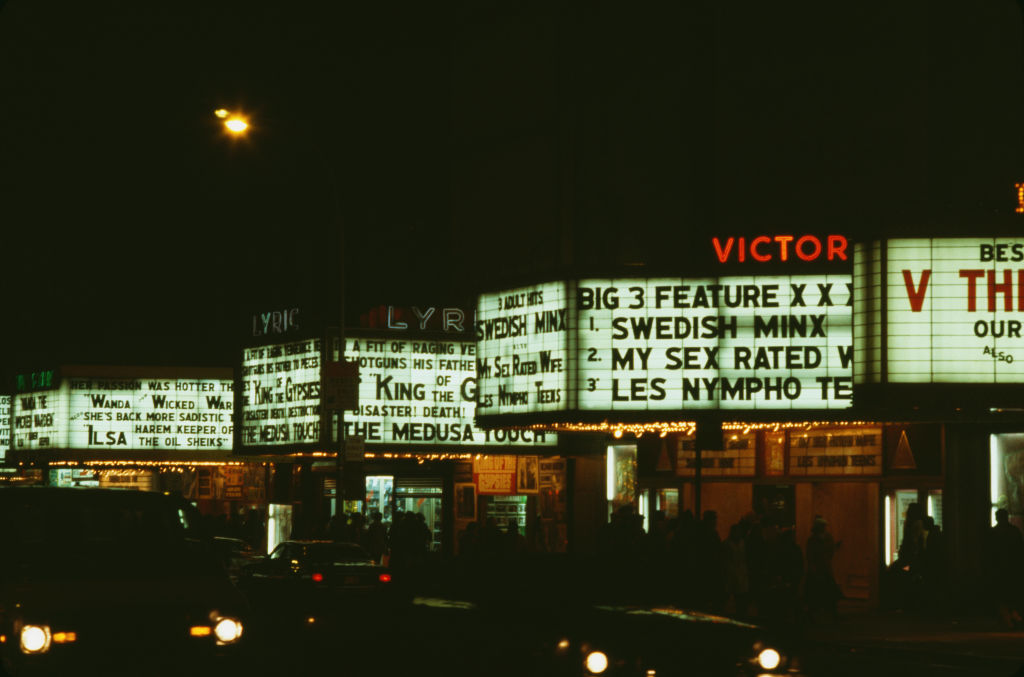One of the more intriguing reissues of the 2020s is a rare, 50-year-old album by a band with a crap name. In Fall 1972, Greene Bottle Records, a subsidiary of Paramount, released the debut album by a New York City group called Pool-Pah, who combined odd synth excursions and strutting funk with winding prog arrangements and melancholy pop choruses. Just when the record was picking up a little steam, the label abruptly cut off all promotion, trashed the remaining LPs, and dropped the band.
The reason: The band had written most of the songs for an X-rated film called The Flasher (originally titled Forbidden Under Censorship of the King, aka F.U.C.K.), starring Harry Reems (billed under his real name, Herb Streicher) as a sexologist studying various fetishes. It hadn’t done particularly well in theatres, and even Reems’ new Deep Throat notoriety couldn’t save this ambitious porno comedy. Or Pool-Pah’s debut, for that matter. It might have won Best Soundtrack at the New York Erotic Film Festival, but the porno association was too much for Paramount.
To their credit, the members of Pool-Pah took the setback in stride and even embraced the film that ruined their big moment. In August 1973 they staged a show called Spend an Evening with the Flasher at the Beacon Theatre in Manhattan, playing along with clips from the movie. They had strippers and vaudeville acts and an emcee wearing nothing more than a soiled trenchcoat. It was a success, garnering glowing reviews and talk of a college-circuit tour. But the band was broke, and they split up in September. At least one member went on to pop success: keyboard player Rupert Holmes hit number one in 1980 with “Escape (The Piña Colada Song)”.

Long before the Flasher first opened his coat, sex and film and music had been bedfellows, engaged in a ménage à trois that pushed each to new places. In the late 1960s, filmmakers became invested in music as a vital component of the final work, whether or not they considered the film “art” or “smut.” Sex on screen was more prominent in Europe at the time, and when U.S. distributors imported films for distribution, they also imported the sounds of those films, some of which embedded themselves in the popular culture. Everybody knows “Mah Ná Mah Ná,” the undying earworm from Piero Umiliani’s soundtrack for the 1968 mondo sex doc Svezia: inferno e paradiso; it went the ’70s version of viral thanks to Red Skelton and the Muppets. In America, however, porn belonged more to the counterculture, at least until it went mainstream (or mainstream-adjacent) in the early 1970s with Deep Throat, which made a star of Linda Lovelace and a first-amendment martyr of Harry Reems.
In the 1980s adult films briefly flirted with punk aesthetics. Los Angeles hardcore band the Plugz contributed a song to the X-rated New Wave Hookers a year after they appeared on the Repo Man soundtrack. But the switch to video slashed budgets to the extent that filmmaking companies began emphasizing quantity over quality, which made the music more and more incidental. Today, scoring pornos has become a cottage industry within the larger billion-dollar industry, although there seems to be less overlap with the mainstream than there once was.
What’s remarkable now about Pool-Pah’s sole album is the variety of sounds they deployed to soundtrack onscreen sex. There’s never been just one genre associated with porn; name a style and there’s an X-rated film out there that has incorporated it into the action. Like country music? Look up one of the weird hicksploitation flicks by a director named Buckalew. (Or don’t.) Like classical music? Pick up a copy of Wakefield Poole’s landmark Boys in the Sand, where works by Tchaikovsky intensify the magical realism of these Fire Island hookups. Especially considering that most adult film soundtracks are more readily available than the films themselves — many are on major streaming services — these soundtracks still sound good as their own standalone works.
Here are 9 essential vintage porn soundtracks that showcase the range of sounds…
1. ABBA (well, in a proto way): The Seduction of Inga (1968)
Before ABBA took Eurovision and the world by storm in 1974, Benny Andersson was a struggling musician who worked occasionally in film and TV. One of his most notorious projects involved composing film for a softcore flick called The Seduction of Inga, a sequel to the popular Inga (both directed by sexploitation pioneer Joseph Sarno). Andersson’s involvement makes sense, as pop music figures prominently in Seduction: The film finds its nineteen-year-old title character jilted and alone in the big city, living in a rundown building where her neighbors are a brothel madam and a rock band. In addition to some incidental music, Andersson composed the movie’s fairly toothless chamber pop single, “She’s My Kind of Girl”, which was somehow a hit in Japan.
2. Piero Piccioni: Camille 2000 (1969)
Few directors are as adept at staging sex as Radley Metzger, an American who brought a European jet set sensibility to softcore (The Lickerish Quartet), hardcore (The Opening of Misty Beethoven), and flicks in between (Score). One of his great accomplishments, Camille 2000 was well ahead of its time in almost every regard, from its fin-de-’60s ennui to its inflatable furniture to its baroque soundtrack. Piero Piccioni, who composed more than 300 soundtracks to spaghetti westerns, spy flicks, and giallo, mixes orchestral and rock elements, with rococo stabs of Hammond organ, to inject a bit of melancholy to the film’s decadence.
3. The Cyrkle: The Minx (1971)
The Minx could be viewed as a dirty movie about making dirty movies, as it concerns two prostitutes who film their dalliances as a form of corporate espionage. When it was filmed in 1967, the Cyrkle had some countercultural cache, touring with the Beatles and notching a number two hit with “Red Rubber Ball” (co-written by Paul Simon). Their soundtrack is pure Summer of Love bliss, full of Beach Boy harmonies, go-go guitars, and tantric rhythms on “The Party” and “Nicole.” The Minx was shelved for four years, during which time the band broke up and their brand of ’60s pop sounded too naïve for post-Altamont pop culture. Singer/guitarist Tom Dawes found greater success writing such jingles as Alka Seltzer’s “Plop Plop Fizz Fizz.”
4. Bernard “Pretty” Purdie: Lialeh (1974)
You might not know the name Bernard “Pretty” Purdie, but you’ve definitely heard him play on hits for James Brown, Aretha Franklin, Nina Simone, Wilson Pickett, Albert Ayler, Herbie Hancock, even Hall & Oates. Despite releasing several records under his own name, he had little luck as a solo artist, such that his one-off soundtrack for the super-low-budget flick Lialeh remains his best known album. Widely considered to be the first Black porno, the film follows a New York hustler trying to launch a live-sex revue and the woman who becomes his muse. It’s inept in all the ways low-budget pornos are inept, but Purdie elevates it with a buoyant mix of funk and sex. He and his band even appear at the beginning of the film, performing the theme song (“sweet, sweet, sexy Lialeh”) while a topless model dances around them.
5. Alden Shuman: The Devil in Miss Jones (1973)
“The Golden Age of Porn” is a misnomer, as so many of the films that seeped into the mainstream were pretty terrible, especially compared to what was happening in Europe and in the American underground. The Devil in Miss Jones, Gerard Damiano’s grim follow-up to his breakout Deep Throat, was at least ambitious, telling the story of a woman who learns she’s going to hell and tries to live it up as much as possible before the end. The soundtrack, which was recently reissued on Real Gone Music, is surprisingly sophisticated and nuanced, especially at a moment when most adult films were relying on wah-wah rhythms and anonymous rock scores. Alden Shuman mixes in subtle references to Satie and Debussy, yet his orchestrations never sound decadent; instead, he conveys some sympathy for the anti-heroine’s fate. How he became involved in the production is unknown, but he wouldn’t have been hurting for opportunities: He and his brother had already written hits for Patsy Cline, Bing Crosby, and Nat King Cole.
6. Pierre Bachelet and Hervé Roy: Emmanuelle (1974)
Emmanuelle is arguably the most successful softcore film of all time — a massive hit in Europe and America that spawned countless sequels, spoofs, and spin-offs: Black Emmanuelle, Emmanuelle 2000, even Emmanuelle in Space. The original is arguably the best of the lot, yet still problematic. Chronicling the sexual awakening of a French diplomat’s young wife in Thailand, it depicts a kind of sexual imperialism thoroughly intertwined with cultural imperialism. Rather than draw from Thai music traditions, the film imported its own French soundtrack courtesy of songwriter Pierre Bachelet and composer/conductor Hervé Roy. It may be the best aspect of the film, too, as the duo smartly pepper chansons with bits of guitar and synth.
7. Klaus Schulze: Body Love (1977)
It’s hard to say who had more of an impact on their medium: Lasse Braun, who directed Body Love and several other hardcore features, was partly responsible for helping to legalize pornography in parts of Europe and importing it into Italy. Klaus Schulze, as a member of Tangerine Dream and Ash Ra Tempel, is considered one of the foundational figures of modern electronic music, with a string of excellent albums like 1972’s Irrlicht and 1973’s Cyborg. The pair worked together only once, on 1978’s Body Love, and Schulze’s space textures add an almost philosophical flair to Braun’s sex scenes. He followed it up with Body Love Vol. 2 – Additions to the Soundtrack, but never scored another adult film.
8. Patrick Cowley: Afternooners (1982)
Starting in the late 1970s, Patrick Cowley made hits for the dancefloor: He collaborated closely with Sylvester in the late 1970s and enjoyed a few solo club hits like “Menergy” and “Megatron Man.” Working as a composer for a series of gay male porn films, he slowed his Hi-NRG beats down to a lope, with the understanding that dancing and fucking were essentially the same pursuit: a physical act that can lead to sexual and sometimes spiritual ecstasy. For Afternooners, a triptych of hook-up vignettes that is essentially a silent film, he coaxes glittery sounds from his early synthesizers, as though the spectacle is just another form of dance. Sadly, Cowley died of AIDS the same year this film was released, and the soundtrack wasn’t issued until 2017.
9. Mitchell Froom: Café Flesh (1982)Written by Jerry Stahl (Permanent Midnight) and directed by someone named Rinse Dream (the nom de porn of Stephen Sayadian), Café Flesh is a truly bizarre experimental art-porn flick — part Grand Guignol comedy, part post-apocalyptic fever dream. In a dystopian future, nuclear fallout has rendered most of the world’s popular sexless, and every night the Sex Negatives gather to watch the Sex Positives fuck each other in an underground nightclub. The staged vignettes are soundtracked by the strange blurps and blarfs of Mitchell Froom’s synthesizers, which render everything just a little more engagingly perverse. Even when it was released as Froom’s solo debut and retitled The Key of Cool, the music lost none of its unusual swing. He later produced albums for Suzanne Vega, Crowded House, Rufus Wainwright, and Bonnie Raitt. The directing-screenwriting-scoring trio did reunite in 1989 for a softcore follow-up, the equally odd Dr. Caligari.


Leave a comment